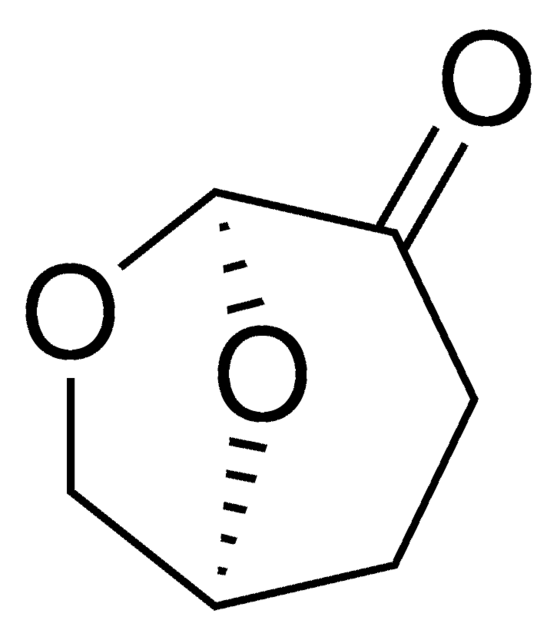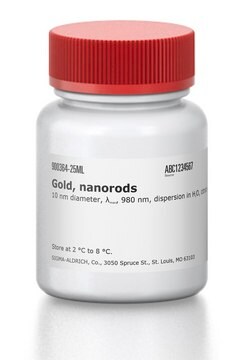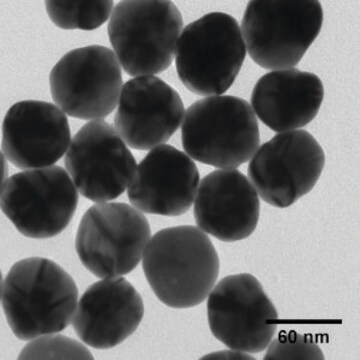716898
Gold nanorods
carboxyl terminated, 10 nm diameter, λmax, 808 nm, dispersion in H2O
Sinónimos:
Au nanorods, Gold nanorod
About This Item
Productos recomendados
Formulario
colloidal suspension
dispersion in H2O
nanorod
concentración
≥1800.0 μg/mL
diám. × L
10 nm × 41 nm ± 10%
impurezas
<0.0001% CTAB
diámetro
10 nm
pH
6-8
densidad
1 g/mL at 25 °C
λmáx.
808 nm
Mw/Mn
(<10% CV, monodispersity)
>95 (rods)
grupo funcional
carboxylic acid
temp. de almacenamiento
2-8°C
cadena SMILES
[Au]
InChI
1S/Au
Clave InChI
PCHJSUWPFVWCPO-UHFFFAOYSA-N
¿Está buscando productos similares? Visita Guía de comparación de productos
Aplicación
- Tuning of chemical interface damping in single gold nanorods through pH-dependent host-guest interactions using cucurbit[6]uril.: This study demonstrates how the functional properties of gold nanorods can be dynamically tuned using pH-sensitive interactions, opening new avenues for high-precision biosensing applications, crucial in both pharma and biotech industries (Kim and Ha, 2024).
- Ultrasensitive SERS aptasensor using Au@Ag bimetallic nanorod SERS tags for the selective detection of amantadine in foods.: Gold nanorods are utilized to enhance the sensitivity of surface-enhanced Raman scattering (SERS) for detecting contaminants in food products, highlighting their role in ensuring safety and compliance in the food industry (Wang et al., 2024).
- In situ pulmonary mucus hydration assay using rotational and translational diffusion of gold nanorods with polarization-sensitive optical coherence tomography.: This innovative application demonstrates the use of gold nanorods in medical diagnostics, specifically for assessing lung health, which is vital for respiratory research in clinical settings (Oeler et al., 2024).
- 4D-STEM Mapping of Nanocrystal Reaction Dynamics and Heterogeneity in a Graphene Liquid Cell.: Highlights the application of gold nanorods in advanced materials research, particularly in visualizing nanoscale chemical reactions which are crucial for developing new nanomaterials for various industrial applications (Liu et al., 2024).
Propiedades físicas
Información legal
Código de clase de almacenamiento
12 - Non Combustible Liquids
Clase de riesgo para el agua (WGK)
WGK 1
Punto de inflamabilidad (°F)
Not applicable
Punto de inflamabilidad (°C)
Not applicable
Elija entre una de las versiones más recientes:
¿Ya tiene este producto?
Encuentre la documentación para los productos que ha comprado recientemente en la Biblioteca de documentos.
Los clientes también vieron
Artículos
Gold nanostructures such as nanorods, nanowires and microgold have found applications in exciting fields such as biomedical engineering, catalysis and diagnostics.
A key challenge for nanomaterial safety assessment is the ability to handle the large number of newly engineered nanomaterials (ENMs), including developing cost-effective methods that can be used for hazard screening.
In many technologies, performance requirements drive device dimensions below the scale of electron mean free paths (λe). This trend has increased scientific interest and technological importance of electrical resistivities at the nanoscale.
Inorganic nanomaterials are tunable by size, shape, structure, and/or composition. Advances in the synthesis of well-defined nanomaterials have enabled control over their unique optical, electronic, and chemical properties stimulating tremendous interest across a wide range of disciplines. This article illuminates some of the recent research advances of inorganic nanoparticles (NPs) in optoelectronics applications.
Nuestro equipo de científicos tiene experiencia en todas las áreas de investigación: Ciencias de la vida, Ciencia de los materiales, Síntesis química, Cromatografía, Analítica y muchas otras.
Póngase en contacto con el Servicio técnico







